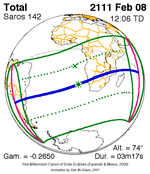A total solar eclipse occurred on October 10, 1912.[1][2][3] A solar eclipse occurs when the Moon passes between Earth and the Sun, thereby totally or partly obscuring the image of the Sun for a viewer on Earth. A total solar eclipse occurs when the Moon's apparent diameter is larger than the Sun's, blocking all direct sunlight, turning day into darkness. Totality occurs in a narrow path across Earth's surface, with the partial solar eclipse visible over a surrounding region thousands of kilometres wide. Totality was visible from Ecuador, Colombia, northern tip of Peru and Brazil.
YouTube Encyclopedic
-
1/1Views:755
-
NYC Skyline 2017 - Annotated (with Trump locations)
Transcription
Observation
German physicist, mathematician and astronomer Johann Georg von Soldner calculated the gravitational lens effect in an article published in 1801. Albert Einstein got similar values in 1911, and proposed verifying it by observing the stars around the sun. The only feasible way at that time was observing during a total solar eclipse, when the sun is totally blocked. This was the first total solar eclipse after that.[4] Local teams from Brazil and international teams from the United Kingdom, France, the German Empire, Argentina and Chile made attempts in Brazil. However, it rained throughout almost the whole path of totality, and all teams failed.[5]
Related eclipses
Solar eclipses 1910–1913
This eclipse is a member of a semester series. An eclipse in a semester series of solar eclipses repeats approximately every 177 days and 4 hours (a semester) at alternating nodes of the Moon's orbit.[6]
| Solar eclipse series sets from 1910 to 1913 | ||||
|---|---|---|---|---|
| Ascending node | Descending node | |||
| 117 | May 9, 1910 Total |
122 | November 2, 1910 Partial | |
| 127 | April 28, 1911 Total |
132 | October 22, 1911 Annular | |
| 137 | April 17, 1912 Hybrid |
142 | October 10, 1912 Total | |
| 147 | April 6, 1913 Partial |
152 | September 30, 1913 Partial | |
Saros series 142
It is a part of Saros cycle 142, repeating every 18 years, 11 days, containing 72 events. The series started with partial solar eclipse on April 17, 1624. It contains one hybrid eclipse on July 14, 1768, and total eclipses from July 25, 1786 through October 29, 2543. The series ends at member 72 as a partial eclipse on June 5, 2904. The longest duration of totality will be 6 minutes, 34 seconds on May 28, 2291. All eclipses in this series occurs at the Moon’s descending node.[7]
| Series members 17–41 occur between 1901 and 2359 | ||
|---|---|---|
| 17 | 18 | 19 |
 October 10, 1912 |
 October 21, 1930 |
 November 1, 1948 |
| 20 | 21 | 22 |
 November 12, 1966 |
 November 22, 1984 |
 December 4, 2002 |
| 23 | 24 | 25 |
 December 14, 2020 |
 December 26, 2038 |
 January 5, 2057 |
| 26 | 27 | 28 |
 January 16, 2075 |
 January 27, 2093 |
 February 8, 2111 |
| 29 | 30 | 31 |
 February 18, 2129 |
 March 2, 2147 |
 March 12, 2165 |
| 32 | 33 | 34 |
 March 23, 2183 |
 April 4, 2201 |
 April 15, 2219 |
| 35 | 36 | 37 |
 April 25, 2237 |
 May 7, 2255 |
 May 17, 2273 |
| 38 | 39 | 40 |
 May 28, 2291 |
 June 9, 2309 |
 June 20, 2327 |
| 41 | ||
 June 30, 2345 | ||
Notes
- ^ "SOLAR ECLIPSE. Disappointed Scientists". Manchester Evening News. Manchester, Greater Manchester, England. 1912-10-11. p. 6. Retrieved 2023-11-03 – via Newspapers.com.
- ^ "TOTAL ECLIPSE OF THE SUN OCT. 10". Martinsburg Statesman-Democrat. Martinsburg, West Virginia. 1912-10-11. p. 2. Retrieved 2023-11-03 – via Newspapers.com.
- ^ "SOLAR ECLIPSE FAILURE". Leicester Mercury. Leicester, Leicestershire, England. 1912-10-11. p. 5. Retrieved 2023-11-03 – via Newspapers.com.
- ^ Helmut Hornung (26 May 2015). "A solar eclipse sheds light on physics". Phys.org. Archived from the original on 26 November 2020.
- ^ "GENERAL NOTES". Astronomical Society of the Pacific. December 1912. pp. 288–290. Archived from the original on 28 August 2019.
- ^ van Gent, R.H. "Solar- and Lunar-Eclipse Predictions from Antiquity to the Present". A Catalogue of Eclipse Cycles. Utrecht University. Retrieved 6 October 2018.
- ^ http://eclipse.gsfc.nasa.gov/SEsaros/SEsaros142.html
Additional reading
- Paolantonio, Santiago (2019). "Eclipse de 1912 en Brasil. Primera tentativa de medir la deflexión de la luz y comparar con el valor propuesto por Einstein de 1911" [Eclipse of 1912 in Brazil. First attempt to measure the deflection of light and its comparison with the value proposed by Einstein in 1911]. Revista Brasileira de Ensino de Física (in Spanish). 41 (suppl 1). doi:10.1590/1806-9126-rbef-2019-0206. ISSN 1806-9126. S2CID 213858006.
References
- Earth visibility chart and eclipse statistics Eclipse Predictions by Fred Espenak, NASA/GSFC




